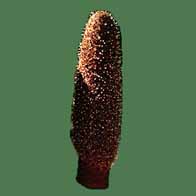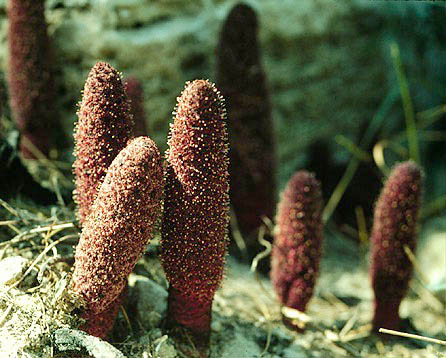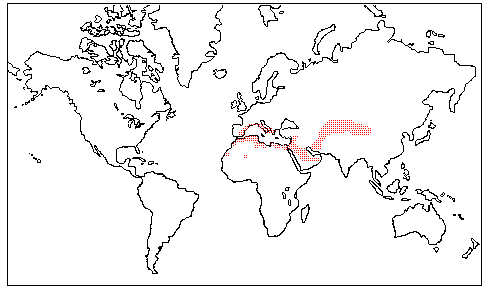 |
Cynomoriaceae Lindl.
|
Cynomorium has two
species, C. coccineum of northern Africa and the Mediterranean
region and C. songaricum of western Asia. The latter species,
known as "suo yang" in Chinese and is extensively used in herbal
medicines. The genus is sometimes included within Balanophoraceae, but
unlike that family it has bisexual flowers intermixed with male and female
flowers within the dense inflorescence. Cynomorium has been known
for thousands of years by ancient people who used it for food, medicine,
and even for dyeing. Arabs call the plant "tarthuth" and Bedouins ate the
interior portions of fresh young stems, prepared infusions of older stems
to treat colic or stomach ulcers, or dried and pulverized the plant for
use as a spice or condiment with meat dishes (see wonderful article by
Robert Lebling HERE).
Medicinal
uses of tarthuth can be traced to Al-Kindi, Al-Razi (Rhazes), Ibn
Masawayh, Ibn Wahshiya, and Maimonides but the plant became known to
Europeans only in the 16th century. A group called the Knights Hospitaller
of St. John operated a hospital in Jerusalem and learned of the medicinal
qualities of tarthuth from local Muslim physicians. When the Crusaders
lost Jerusalem to the Muslims, they moved to the island of Malta where Cynomorium
was also native. The site where "Maltese Mushroom" grew (Fungus Rock) was
thereafter vigorously guarded and thieves were imprisoned or made galley
slaves. The "treasure of drugs," as the Arabs called it, was used for a
variety of purposes, including treating apoplexy, venereal disease, high
blood pressure, vomiting, irregular menstrual periods and as a
contraceptive and toothpaste. In his book "The Private Life of Plants,
David Attenborough implies that the medicinal qualities of Cynomorium
can be attributed to the "Doctrine of Signatures," i.e. that if a plant
bore a physical resemblance to a part of the human body, this plant was
useful in treating a disease associated with that part. For example,
because Cynomorium appears reddish-brown and darkens upon drying,
it could be considered useful in treating ailments of the blood. Moreover,
the phallic shape meant the plant could also be used to treat sexual
problems. Evidence is now accumulating that the ancient Muslims may have
been correct with regard to the medicinal qualities of tarthuth. See
References (below) for modern pharmacological work aimed at determining
actual biochemical activity.
Photographs
Cynomorium coccineum
- Habit of plant showing
inflorescences emerging from the sand. The parasite attaches to the host
roots via a massive haustorial system deep underground. Cadiz, Spain.
Photo of specimen no. 4063 by D. L. Nickrent.
- Inflorescences.
Northeastern Tunisia. Photo by Stefan Wanke spring 2006.
- Close-up photograph showing
female flower (left and middle) and male flower (right). Photo by D. L.
Nickrent.
- SEM (Scanning electron micrograph)
of the pollen. Photo by D. L. Nickrent.
- Tarthuth emerging from the sand. Ain
Dar, Eastern Province, Saudi Arabia, Feb. 21, 2005. Photo by Stephen L.
Brundage (Saudi Aramco).
- View of tarthuth in its desert
habitat in the Ain Dar area of Saudi Arabia's Eastern Province,
close to the Ghawar oil field. Photo taken in March 2004 by Faisal I.
Al-Dossary (Saudi Aramco).
- Young inflorescence of tarthuth
just emerging from sand. Note the presence of scales intermingled with
the dense, still unopended flowers. Photo by Faisal I. Al-Dossary (Saudi
Aramco).
- Young inflorescence being visited
by ants. Photo by Faisal I. Al-Dossary (Saudi Aramco).
- Inflorescence being visited by
flies. Photo by Faisal I. Al-Dossary (Saudi Aramco).
- A toad-headed agamid lizard (Phyrnocephalus
maculatus) taking advantage of the flies attracted to tarthuth.
Photo by Faisal I. Al-Dossary (Saudi Aramco).
- Mr. Quriyan M. Al-Hajri (in western dress) harvesting tarthuth (Photo1,
Photo2). Mr. Al-Hajiri is
supervisor of Saudi Aramco's Wellsites Inspection Unit and is also an
expert on desert lore, Bedouin traditions and survival techniques. Photo
by Faisal I. Al-Dossary (Saudi Aramco).
- Mr. Quriyan M. Al-Hajri (in Saudi dress) harvesting tarthuth (Photo1,
Photo2). Photo by Faisal I.
Al-Dossary (Saudi Aramco).
- Tarthuth, partially excavated.
The inflorescence can be quite long, with the actual haustorial
connection to the host many decimeters below the soil. Photo by Faisal
I. Al-Dossary (Saudi Aramco).
- Excavated inflorescences of
tarthuth next to an intact one. Photo by Faisal I. Al-Dossary (Saudi
Aramco).
- Inflorescence in hand.
Abarkouh region, Iran. Photo spring 2008 by Rasoul
Rasoulpour.
- Photos.
Plant from Spain. Link goes to
Flora of the World.
Cynomorium songaricum
- Photos of this
species. Link goes to the
PlantPhotoBank.cn web site.
- Suo Yang as it is sold
dried and packaged as an herbal medicine for "invigorating the yang",
nourishing the blood, moistening the intestines, "locking up the kidney
essence" which assures male potency in old age, and many other purported
remedial effects.
- Typical advertisement for Suo
Yang seen on many web pages, complete with misspelled Family name!
Efforts must begin to conserve this plant where it is being extensively
harvested from natural populations.
Phylogeny
This family, containing only the genus Cynomorium,
was treated as a member of Balanophoraceae in Kuijt (1969). The concept
that the two families were separate is not new. In fact, Takhtajan’s 1987
classification placed Balanophoraceae in Magnoliidae and Cynomoriaceae in
Rosidae. Unfortunately in his 1997 classification he re-united them
with Balanophoranae! Nickrent et al. (2005 BMC Evol. Biol. pdf HERE)
showed that Cynomoriaceae was not closely related to Balanophoraceae but
was a component of Saxifragales.
A large-scale study of angiosperms (561 taxa) by Jian et al. (2008 Syst.
Bot.) questioned our result, indicating that Cynomorium
belonged in Santalales. These data are unpublished, nor was a
voucher indicated. But given the phylogenetic position, it is
possible the authors accidentally used a sample of Balanophoraceae. It
should also be pointed out that these authors erroneously indicated less
than 50% bootstrap support for a Cynomorium
/ Saxifragales relationship in Nickrent et al. (2005). This is not
accurate, for this relationship had 98/100 (MP/Bayesian) support. Also,
Nickrent et al. (2005) included Santalales and Balanophoraceae in their
analyses, thus Cynomorium had
“the opportunity” to group with these taxa, but it did not. Thus, at this
time it does not appear that sufficient data exist to consider seriously
this alternate result.
But the confusion doesn’t stop there! In 2009 Zhang et al. (Journal
of Systematics and Evolution, published in China) conducted a phylogenetic
study using the chloroplast inverted repeat. They showed that Cynomorium
songaricum was sister to Rosaceae (Prunus
and Fragaria) with 99% BS
support.
The evidence supporting (and not supporting) the phylogenetic placement
of Cynomoriaceae among angiosperms was discussed in a Supplement to Su et
al. (2015) HERE.
More recently, the position of this family within Saxifragales has been
confirmed in Bellot et al. (2016. Assembled plastid and mitochondrial
genomes, as well as nuclear genes, place the parasite family Cynomoriaceae
in the Saxifragales. Genome Biology and Evolution 8:2214–2230).
But it seems that some authors insist on "beating a dead horse", making
false statements about previous phylogenetic work, and ignoring
overwhelming evidence. The very recent book by Soltis et al. (2018,
Phylogeny and evolution of the angiosperms, The University of Chicago
Press) on p. 195 said "Some analysis [sic] placed Cynomorium
coccineum (Cynomoriaceae) in Saxifragales (Nickrent et al. 2005),
albeit with low support." The erroneous Santalales and Rosales
positions are also repeated here (why is this necessary?) and the 2016
work from the Renner lab is not cited. The closing statement "Obviously,
more study of Cynomoriaceae is required" may be true in terms of various
fascinating molecular evolutionary questions, but it is certainly not true
in terms of phylogenetic placement!


Last updated: 15-Nov-20 / dln



